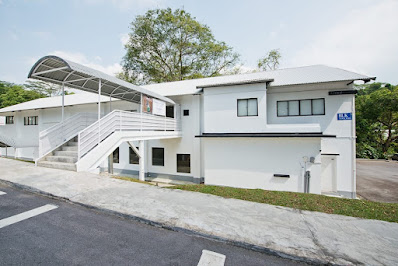Gillman Barracks : Military Barracks turned Contemporary Arts Paradise
Gillman Barracks
History
Gillman Barracks was constructed in 1936 and its location was chosen due to its proximity to the sea. Gillman Barracks was named after the late General Sir Webb Gillman, who was a highly respected officer of the British army and who came to Singapore for 3 months in 1927 to assess the defence capability of the British Naval Base.
The 1st Battalion, Middlesex Regiment and the 2nd Battalion, Loyal Regiment of the British army were based in Gillman Barracks as part of a plan to facilitate the expansion of the British army in Singapore. Structures at Gillman include officers' married quarters, sports facilities, officers' messes, barrack buildings and regimental institutes.
During the Second World War, the British regiments fought the Japanese for three days prior to the fall of Singapore in February 1942.
Gillman Barracks was one of the last British military base to fall to the Japanese. After the Japanese surrender on 14 August 1945, Gillman Barracks was returned to the British forces.
In 1971, the Singapore Armed Forces(SAF) took control of Gillman Barracks from the British , after the British withdrew their forces from Singapore. For the next 13 years , the site was home to the School of Combat Engineering and the 3rd Transport Battalion of the Singapore Armed Forces. Subsequently, in 1984, the SAF Transport Base took over the space from the School of Combat Engineering. In 1990, SAF vacated the camp and the area was repurposed for commercial usage with a new name of "Gillman Village". Cafes, restaurants, bars and shops moved into the area with hopes of attracting people to this hidden enclave blending colonial charm and delicious food options. However, Gillman Village ultimately failed to take off as it could not attract enough human traffic to its location.
Notable Buildings
The 1st Battalion, Middlesex Regiment and the 2nd Battalion, Loyal Regiment of the British army were based in Gillman Barracks as part of a plan to facilitate the expansion of the British army in Singapore. Structures at Gillman include officers' married quarters, sports facilities, officers' messes, barrack buildings and regimental institutes.
During the Second World War, the British regiments fought the Japanese for three days prior to the fall of Singapore in February 1942.
Gillman Barracks was one of the last British military base to fall to the Japanese. After the Japanese surrender on 14 August 1945, Gillman Barracks was returned to the British forces.
In 1971, the Singapore Armed Forces(SAF) took control of Gillman Barracks from the British , after the British withdrew their forces from Singapore. For the next 13 years , the site was home to the School of Combat Engineering and the 3rd Transport Battalion of the Singapore Armed Forces. Subsequently, in 1984, the SAF Transport Base took over the space from the School of Combat Engineering. In 1990, SAF vacated the camp and the area was repurposed for commercial usage with a new name of "Gillman Village". Cafes, restaurants, bars and shops moved into the area with hopes of attracting people to this hidden enclave blending colonial charm and delicious food options. However, Gillman Village ultimately failed to take off as it could not attract enough human traffic to its location.
Notable Buildings
Block 9
Being the main and biggest block in the site, this building was designated as a Warrant Officers and Sergeants Mess when it was built in 1936. The building structure went through World War II relatively unscathed. After the Japanese surrender in 1945, it served as a mess for the Royal Engineers all the way till the British forces withdrawal in 1971
Block 7
After World War II, block 7 was designated as a Cinema to entertain the British troops stationed at Gillman Barracks. It was managed by the newly established Army Kinema Corporation (AKC) . Two movies were screened daily with the exception of Tuesday. The AKC logo was retained on the side of the building even till today. Block 7 is the sole building with a pointed roof within Gillman Barracks
Present
In 2010, the Singapore government undertook efforts to revitalise and redevelop Gillman Village while also deciding to revert the site to its previous name of Gillman Barracks. Gillman Barracks launched in September 2012 as a comtemporary art centre. It started with 13 art galleries , including galleries with a long successful history such as Sundaram Tagore Gallery and Tomio Koyama Gallery.
In 2019 , Gillman Barracks was one of the few venues that hosted art spaces as part of the Singapore Biennale.
Today, Gillman Barracks continue to be a host of world class contemporary artworks from around the world. Enjoy a day trip here to experience the rich history and heritage behind Gillman Barracks' colonial architecture while gaining inspiration from the contemporary artworks hosted in the galleries!
Shops at Gillman Barracks
Creamier - Cafe selling delicious ice-cream, waffles and coffee
The Blackbird - Live music bar
Wheeler's Tropikana - Fancy restaurant with a nice ambience and live band
Handlebar - Biker themed bar. (Try their chicken wings! )
Naked Finn - Seafood restaurant serving dishes with an Asian flavour
Hopscotch - Restaurant specialising in oysters , seafood, and meat offerings plus unique cocktails and craft beer
Kaffa Bella Acai & coffee - Cafe decorated with motorcycles , offering Acai , pastries and beverages
Directions : Travel to Labrador Park MRT (CC27 ). Walk north along Alexandra Road for around 7 mins and turn in at Malan Road to reach Gillman Barracks.






Comments
Post a Comment